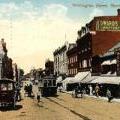 The Eastern Townships' principal city is Sherbrooke. With a population of 150,000, it dominates the region. Sherbrooke is situated at the confluence of the St. Francis and Magog rivers. In Abenaki times, these two rivers were important navigable waterways for travelling through the region. What is now Sherbrooke was the site of a portage at the falls of the Magog River. Known in Abenaki as Ktinékétolékouac, the site was later called Grandes Fourches or Big Forks, to distinguish it from Little (or Lower) Forks (Lennoxville), which was situated upstream at the junction of the St. Francis and Massawippi rivers.
The Eastern Townships' principal city is Sherbrooke. With a population of 150,000, it dominates the region. Sherbrooke is situated at the confluence of the St. Francis and Magog rivers. In Abenaki times, these two rivers were important navigable waterways for travelling through the region. What is now Sherbrooke was the site of a portage at the falls of the Magog River. Known in Abenaki as Ktinékétolékouac, the site was later called Grandes Fourches or Big Forks, to distinguish it from Little (or Lower) Forks (Lennoxville), which was situated upstream at the junction of the St. Francis and Massawippi rivers.
The first permanent settlement at Big Forks was established by United Empire Loyalist Gilbert Hyatt. Hyatt, who had received a warrant to survey Ascot Township in 1792, was not granted the township until 1803. By that time, he had already built mills at the site, and a number of other pioneer families had arrived from New England. The little settlement was soon being referred to as Hyatt's Mills. In 1818, Hyatt's Mills was renamed Sherbrooke (after Governor General Sir John Coape Sherbrooke).
Growth in Sherbrooke was slow at first. Like elsewhere in the Eastern Townships, the area suffered from isolation due to the poor quality of roads to the outside world. Sherbrooke did gain some early advantages, however. In 1823, it was the made the seat of the new judicial District of St. Francis. It was also the site of the Townships' first jail. In the 1830s, it became the seat of the powerful new British American Land Company. An increasing number of influential businessmen, landowners, and office-holders were establishing themselves in the town. Sherbrooke was becoming the "chef-lieu" of the Eastern Townships.
Rapid growth, however, only occurred with industrialization. This began in the 1840s and increased dramatically after the completion of the St. Lawrence & Atlantic Railway (Grand Trunk) between Montreal and Portland, Maine, in the 1850s. Textile mills, some quite substantial, were the major industries.
Like many parts of the Townships, Sherbrooke was essentially English-speaking in the first half of the 19th century. This changed with industrialization. New employment opportunities, the railroad, the availability of cheap land, overcrowding in the old seigneurial lands, and the creation of colonization societies in French Canada, attracted thousands of French Canadians to the area. The region saw several waves of immigration from French Canada after the mid-19th century. Many of the new arrivals found jobs in the mills and factories of Sherbrooke.
 French Canadians brought with them not only their language but their religion. With the increasing number of French-speaking Catholics in the area, the Diocese of Sherbrooke was created in 1874, with Antoine Racine as its first Bishop.
French Canadians brought with them not only their language but their religion. With the increasing number of French-speaking Catholics in the area, the Diocese of Sherbrooke was created in 1874, with Antoine Racine as its first Bishop.
Sherbrooke also became an important regional banking centre during this period. With the creation of the Eastern Townships Bank in 1859, with its head office in Sherbrooke (and branches in Waterloo and Stanstead), the town's position as the region's financial capital was ensured. In the second half of the century, the bank expanded its operations throughout the region, with branches in most major towns. In the 1880s, a second major railroad, the Quebec Central, was completed through Sherbrooke, this time running north-south. Mining, agriculture, and the service sector all contributed to Sherbrooke's growth.
Today the City of Sherbrooke is a regional leader in many sectors, not least of which are education, entertainment, and culture. For example, Sherbrooke, is home to the Université de Sherbrooke. It also boasts a Symphony Orchestra. It has two daily newspapers (one French, one English), and radio and television stations. Sherbrooke has a number of museums and interpretation centres.